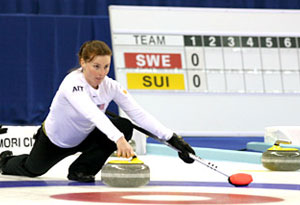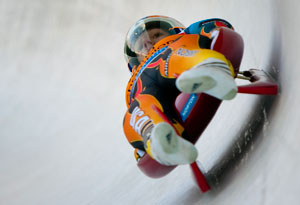
Photo: Rick Patzke, USA Curling
The figure skaters capture much of the spotlight at the Winter Olympics, but what about the gun-toting skiers, the broom-wielding curlers, the speeding-bullet sledders? In anticipation of the Vancouver games (February 12 through 28), O talked to four U.S. hopefuls about their idiosyncratic pursuits.
Curling
Allison Pottinger, 36
How it works: Think of curling as a mix of bocce and shuffleboard…on ice. A team of four slides a granite stone toward a target; armed with brooms, the curlers jump in to sweep the surface, coaxing the stone to travel straighter and farther. "One of my jobs is to communicate the next play to my teammates," says Pottinger, a onetime world champion (she's also a wife, mother, and marketing analyst for General Mills in Minneapolis).
Why she does it: The Canadian-born Pottinger has been sweeping since the age of 12, when her father took her to a curling club after they moved to Otterburn Park, Québec. "Curling is about strategy," she says, "so when we win, it means we've outplayed our opponents both mentally and physically—and that's a great combination."
Biathlon
Haley Johnson, 28
How it works: The competitors cross-country ski around a 1.5-mile track with rifles strapped to their backs, stopping to shoot at targets from both prone and standing positions. The athletes get just one bullet per bull's-eye, and each miss means a 150-meter penalty lap. "You can be the fastest skier out there, but if you aren't hitting the target, you're not going to win," Johnson says.
Why she does it: Skiing since age 2, Johnson started shooting at 15, when the U.S. Biathlon Association set up a recruiting camp in her hometown of Lake Placid, New York. "It's amazing to do two completely different sports at once," says Johnson, who has enough sponsorships to train full-time. "When I'm skiing, I'm in a physical mode and moving incredibly fast. When I head to the shooting range, I have to make a big mental transition from skier to shooter. It's a switch I continue to try to master."

Photo: Tony Benshoof
Skeleton
Noelle Pikus-Pace, 27
How it works: Imagine running as fast as you can while pushing a sled weighing as much as 77 pounds, then diving aboard to hurtle face-first down a curvy, mile-long track, reaching speeds of up to 90 miles per hour. "Skeleton is an adrenaline-junkie sport," says Utah-born Pikus-Pace, who missed the 2006 Olympics after a freak accident at the Alberta trials—a runaway bobsled jumped its track and slammed into her. ("I looked down and saw bone protruding from my leg," she recalls.)
Why she does it: "I love the speed and the exact body movements," says Pikus-Pace, mother of a 2-year-old girl. "I steer by using subtle pressure points on the sled below my shoulders and knees; sometimes you'll see me steer by dragging my feet on the ice. It's like a dance."
Luge
Erin Hamlin, 23
How it works: The racer, or "slider," sits on her sled and grabs two handles at hip height on either side of the track, rocking back and forth to build momentum. Next she launches herself forward, paddling the icy course with spike-covered gloves to accelerate her sled. Then comes the fun part: She lies back and begins a mostly blind, blistering, feet-first ride. "People think we just lie there and slide down the track, but it's very precise," says Hamlin, who has clocked a top speed of 88 mph. "We're steering with our legs and hands and by shifting our body weight."
Why she does it: Though Hamlin became world luge champion last year (she's the first non-German woman to win the title since 1993), she wasn't always a natural. "I had the basics of steering and body control. I just wasn't the fastest kid," says Hamlin, who started sliding in Syracuse, New York, at age 12. "But luge challenged me, and it was the challenge that kept me hooked."
Meet the top female snowboarders in the country
Noelle Pikus-Pace, 27
How it works: Imagine running as fast as you can while pushing a sled weighing as much as 77 pounds, then diving aboard to hurtle face-first down a curvy, mile-long track, reaching speeds of up to 90 miles per hour. "Skeleton is an adrenaline-junkie sport," says Utah-born Pikus-Pace, who missed the 2006 Olympics after a freak accident at the Alberta trials—a runaway bobsled jumped its track and slammed into her. ("I looked down and saw bone protruding from my leg," she recalls.)
Why she does it: "I love the speed and the exact body movements," says Pikus-Pace, mother of a 2-year-old girl. "I steer by using subtle pressure points on the sled below my shoulders and knees; sometimes you'll see me steer by dragging my feet on the ice. It's like a dance."
Luge
Erin Hamlin, 23
How it works: The racer, or "slider," sits on her sled and grabs two handles at hip height on either side of the track, rocking back and forth to build momentum. Next she launches herself forward, paddling the icy course with spike-covered gloves to accelerate her sled. Then comes the fun part: She lies back and begins a mostly blind, blistering, feet-first ride. "People think we just lie there and slide down the track, but it's very precise," says Hamlin, who has clocked a top speed of 88 mph. "We're steering with our legs and hands and by shifting our body weight."
Why she does it: Though Hamlin became world luge champion last year (she's the first non-German woman to win the title since 1993), she wasn't always a natural. "I had the basics of steering and body control. I just wasn't the fastest kid," says Hamlin, who started sliding in Syracuse, New York, at age 12. "But luge challenged me, and it was the challenge that kept me hooked."
Meet the top female snowboarders in the country




